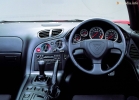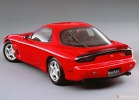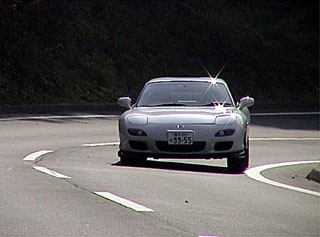Test Drive Mazda RX-7 FD 1992 - 2002 coupe
Crusade
How it was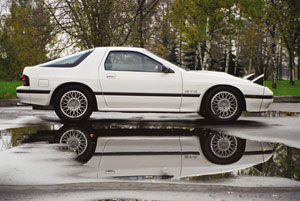 One day a 17-year-old German boy dreamed of a dream - he was driving at some concert in the car of his own design, with an unusual engine in which there was no piston. It happened in 1919, and the name was the guy Felix Vankel.
One day a 17-year-old German boy dreamed of a dream - he was driving at some concert in the car of his own design, with an unusual engine in which there was no piston. It happened in 1919, and the name was the guy Felix Vankel. No special knowledge in the field of mechanics Vankel did not possess, but a seriously doned took place. In 1924, he already had a small her own workshop in Heidelberg, where he fought with all sorts of glands. There and the design of the rotary engine was born (the very idea of \u200b\u200bsuch a motor is much older - the earliest descriptions include as much as 1673, and in the 1759th James Watt created a steam version).
I started Wankel from rotary compressors - he received his first patent in 1929. It was followed by a patent for the rotary motor DKM (1936), work at the Ministry of Aviation, a number of large companies, including BMW and Daimler-Benz. After the war, Vankel's laboratory defeated, and he himself was arrested and a year spent in prison.
In 1951, the work resumed - Vankel managed to interest NSU on his ideas. In February 1957, the first launch of the DKM engine took place, a year later the KKM appeared - the prototype of modern rotary motors, and another year with a small NSU officially announced: the rotor Vankel engine was created and works.
Requests of technical cooperation fell from all sides. Interest in a new motor showed about 100 firms, of which 34 are Japanese. NSU, \u200b\u200bbefore that, produced motorcycles, began production of cars - the population is rich and could already afford to transfer from two wheels to four. But a significant part of the company's cash revenues was revenues from the sale of licenses for the Vankel engine (at the same time NSU came very wisely - license buyers were required to share the results of their work on improving the engine).
List of automakers who have acquired licenses are sufficiently impressive. Among them are General Motors, Ford, Citroen, Mercedes, Nissan. And, of course, Mazda.
The first car with a rotary engine is considered to be NSU Spyder 1963 with a single-circuit engine of 497 cm cube. and with a capacity of 50 hp The release was small - in 1964-1967. Produced just over 2,000 cars.
A truly serial model was the NSU RO80 in 1967 sedan, which received the title of European car of the year in the Frankfurt Motor Show 1968. Its two-section engine (2x497 cm cu.) Developed power 115 hp In 1968-1977 Almost 34,000 RO80 copies were released.
The main problem of rotary motors (in addition to their large appetite) was low reliability - in particular, bearings and rotor seals. On maintenance and repair RO80, NSU almost broke out, and was absorbed by the Volkswagen group, in which the rotary engines were poorly understood. But in other companies work on the Vankel engine continued, however, with a little success.
At the Frankfurt Motor Show 1969, visitors struck the concept of Mercedes C111 - with two versions of the engine: three- (320 hp) and four-section (405 hp). Further the concept did not go.
In 1972, Nissan created a prototype of a small sports car, and was even going to produce her serially and in decent quantities (120,000 copies per year). Prevented the oil crisis broken down in 1973.
Citroen was noted - the company has released two cars, AMI 6 (1970) and GS BiroTor (1973) with a KKM 622 motor with a capacity of 107 hp, but then quickly lost interest in the rotary idea.
More enthusiasm showed General Motors Corp. At the insistence of Her President Ed Coula, an Education Engineer, in 1970, a NSU license was acquired, and three years later, the European public was shown by two Corvette cars with the average location of the Vankel engine, 2x266 cm. and 4x390 cm cube. The bodies for them did the PinInfarina Atelier. Next year there was already a serial machine with a rotary engine - Chevrolet Monza ...
From the plans of General Motors a little came out. In 1974, on the eve of the adoption of a new law on the purity of the exhaust, Cole suspended development, and in a month resigned. In 1977, the Corporation officially announced that all work on rotary engines was discontinued.
The only company continued - and successfully work on the Vankel engine was Mazda, which acquired the appropriate license back in 1961. From the design of the NSU with one rotor, they abandoned almost immediately - due to unstable work on small revolutions. In the first half of the 60s, a two-section motor (with two rotors) was brought to mind, and in 1967, the first serial rotary car Mazda - Cosmo Sport (Mazda 110S) was received on sale with a 10a engine (2x491 cm cubic) with a capacity of 110 liters. p., Later increased to 128 hp (Serial - too strongly said, for 5 years released 1176 copies), which kept 100,000 km mileage. The speed of the machine reached 200 km / h.
In 1968, a more earthly coupe appeared on the market - Familia Rotary (Mazda R100) appeared, behind him, Luce Rotary (Mazda R130), Capella Rotary (Mazda RX-3) fell out of the horns of abundance, Savanna (Mazda RX-3). Since 1970, exports of rotary machines in the United States began to export a lot of noise. In 1971, Mazda released 200,000 cars with Vankel engine.
The future seemed so cloudless that the company was going to completely switch to the production of cars with rotary motors. But all the same oil crisis of 1973 prevented. Sales on American - important for the Mazda - market already in 1974 fell twice. About the mass market there are uneconomical rotary cars I had to forget.
On the home market, the positions of cars equipped with the Vankiel engine, also noticeably shaken. In 1975-1977 Limousine RoadPacer AP (800 copies in three years) was produced, in 1975-1981. - Sports Cosmo AP (Mazda RX-5), more couple-triple models. The production of Eunos Cosmo with a three-section turbocharged engine (280 hp) was discontinued in 1995
The only exception is the Savanna RX-7 model (Mazda RX-7), which appeared in 1978 and is still manufactured. The first generation of the car had a mid-door layout and was equipped with an engine 12a (2x573 cm cube., 130 hp). In 1980, Faislifting was held, in 1983 the Motor added turbocharddv (165 hp).
The second generation of RX-7 was launched into the series in 1985. The engine capacity 13b with turbocharging was 185 hp, and four years later rose to 205 hp.
And finally, the third generation appeared in 1991. The turbocharged Motor 13B-REW (2x654 cm. Cube.) Developed the power of 255 hp Faislifting was held in 1996 and 1998, the engine capacity was brought to 280 hp. In the same 1991, a long-term dream of the Mazda sports team was carried out - the car 787b with a four-section rotary engine R26B with a capacity of 700 hp Won a 24-hour race in Le Mana (from next year, only cars with conventional piston engines began to be allowed to participate in the race) ...
 For more than 30 years, different automakers tried to cope with the promising, but capricious creation of Felix Vankel. Lose hands all - except Mazda and ... VAZ, where rotary engines are still made by small series. To tell the truth, the task was not from the lungs - catch up and overtake the traditional designs of motors that brought more than 100 years. It seemed the impression that Mazda was about to surrender and experienced more than the rest. Even the concept of RX-7 did not consult, which company showed at the Tokyo Motor Show in 1995 - few people believed in the future of the car.
For more than 30 years, different automakers tried to cope with the promising, but capricious creation of Felix Vankel. Lose hands all - except Mazda and ... VAZ, where rotary engines are still made by small series. To tell the truth, the task was not from the lungs - catch up and overtake the traditional designs of motors that brought more than 100 years. It seemed the impression that Mazda was about to surrender and experienced more than the rest. Even the concept of RX-7 did not consult, which company showed at the Tokyo Motor Show in 1995 - few people believed in the future of the car. Unbelievers are posted! This year in Tokyo presented a new car - the concept of the RX-EVOLV with the next generation renesis rotary engine! The crusade goes on ...
Russia is one of the few countries where they have not yet abandoned the automotive use of the Vankel engine (in boat engines, motorcycles, lawn miles, and so on. It is widely used all over the world). It is said that the first acting sample at the beginning of the 60s built a single smoothie. Built without any drawings, on just a primitive picture. And gathering on its basis the RAN Helicopter, even flew!
The case went after the rotary motor problem was engaged in us, Nati, VNIOTOmotope, etc. One of the created engines, a single-circuit RD-515, in the mid-70s it was supposed to put on heavy motorcycles. With a weight of 38 kg and a volume of 491 cm cube. He issued 38 hp (6000 rpm.) And 51 nm (3500 rpm). Facial seals made from steel or cast iron. Especially for this motor developed the technology of applying wear-resistant heat-resistant nickel-silicon coating Nicosil on the aluminum base. The unit was keen to overhaul 50 thousand km.
At the beginning of the 80s, the VAZ-311 single-circuit engine was made with a working volume of 647 cm cube., Developed 70 hp (6000 rpm.) And 95 nm (3500 rpm). Weight motor 114 kg. It was the first rotary swallow of Tolyatti ...
Существование отечественных машин с двигателями Ванкеля долгое время не афишировалось, ими пользовались наши спецслужбы, как утверждали посвященные... Чрезвычайная прожорливость моторов заставляла ставить на автомобили дополнительный бензобак.
В последнее время, с пересмотром взглядов на секретность, введением рыночных отношений и возникновением спроса на неординарные автомобили, стали предлагаться восьмерки и десятки с двухсекционными моторами ВАЗ-415. Каждая секция имеет объем 654 см куб., что позволяет достичь мощности 120 л.с. (6500 об./мин.) и крутящего момента 186 Нм (4500 об./мин.). 200 км/ч для десятки - совсем неплохо...
How it works
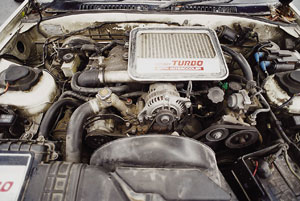 Идея роторно-поршневого двигателя Ванкеля проста - и тем гениальна. Ротор треугольного сечения вращается в неподвижном корпусе, одновременно выполняя внутри него сложную циркуляцию - в силу того, что вращается на эксцентрике рабочего вала, заменяющего здесь привычный коленчатый. В крышке корпуса неподвижно закреплена маленькая шестерня с наружным зацеплением, а в отверстии ротора - другая (побольше), с внутренним. Взаимодействие этих шестерен и обуславливает сложную траекторию перемещения ротора.
Идея роторно-поршневого двигателя Ванкеля проста - и тем гениальна. Ротор треугольного сечения вращается в неподвижном корпусе, одновременно выполняя внутри него сложную циркуляцию - в силу того, что вращается на эксцентрике рабочего вала, заменяющего здесь привычный коленчатый. В крышке корпуса неподвижно закреплена маленькая шестерня с наружным зацеплением, а в отверстии ротора - другая (побольше), с внутренним. Взаимодействие этих шестерен и обуславливает сложную траекторию перемещения ротора. Сечение внутренней полости корпуса повторяет формой и размерами фигуру, рисуемую кромками ротора. В кромках находятся уплотнительные вставки (аналог поршневых колец). Между кромками и корпусом образуются три отдельные рабочие камеры, которые при вращении ротора перемещаются, при этом изменяется их объем. Если в соответствующих местах корпуса расположить впускные и выпускные отверстия и ввернуть свечи зажигания (две на секцию), получится роторный аналог четырехтактного поршневого двигателя. Крутящий момент от ротора на вал передается через плечо эксцентрика. Передаточное отношение шестерен выбрано 2:3, поэтому частота вращения вала в три раза больше, чем у ротора.
Обычный мотор за два оборота коленвала сжигает количество топливо-воздушной смеси, равное своему объему, роторный - в два раза большее. Поэтому рабочий объем последнего принято считать равным двойному объему камеры сгорания, хотя в литературе указывается реальный литраж.
The obvious advantages of the rotor engine are structural simplicity, small dimensions, weight and number of parts (all sorts of distributors-rocker pushers-valves are not required at all), high specific power. If you place the second rotor on the same working shaft on the same work shaft, it turns out a two-section motor, according to its equilibrium, is not inferior to a row six, which is considered in this regard by the reference. Small engine sizes facilitate the task of the car designers.
The narrow place of the Vankel motor is a seal of a pair of a rotor-housing, requiring the high accuracy of the manufacture of conjugable curvilinear surfaces and a competent selection of materials. Well, it is also, perhaps, not too good fuel efficiency and increased oil consumption, which is supplied to the rotor seals and inevitably falls into the combustion chamber.
How it goes
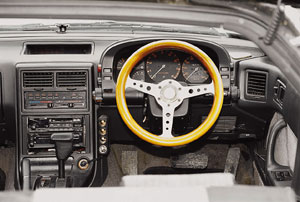 So, today the only serial-produced car with a rotary engine is a sports compartment Mazda RX-7, it is Savanna. For twenty years of production - the life of a whole generation of people - changed fashion, habits ... But the demand for this model is preserved. So, there is something in it. What?
So, today the only serial-produced car with a rotary engine is a sports compartment Mazda RX-7, it is Savanna. For twenty years of production - the life of a whole generation of people - changed fashion, habits ... But the demand for this model is preserved. So, there is something in it. What? Mazda RX-7 is not officially sold in Russia - not found new. Used - also rarity. The main markets for the sale of RX-7 - USA, Japan and Australia, so the test (and not without difficulty) managed to get only a car with the right steering wheel and respectable, 13 years of age (second generation of the model). On the odometer - 90.000 km. The car spent most of his life in his homeland (confirmed by the records in the service book), but half of the wounded kilometer falls on Moscow, where the car is operated for three years, while it has time to change the owner during this time.
There are no complaints about the machine at the host yet - the body is in good condition, the chassis is in order, everything spins-spinning-functions normally. And, most importantly, there is no comments to the engine. In general, it should be: a guaranteed motor mileage is 300,000 km - no less than the usual piston.
Of course, not everything is perfect. From the local gasoline, a catalyst is a single irregular refueling for this. Buried the muffler, which is not surprising, taking into account the age of the car. Service is the most common - replacement of operational fluids, brake pads (the kit costs about $ 40).
True, one major trouble is the master of the owner than delivered (or the master of the car?). The north for me is bad for me - probably, it was thought of a car when it was fed to the local oil poison (the label on the bank does not always correspond to the contents of the latter). Loading in native synthetics, highly breeding (up to 150 thousand rpm.) The compressor turbine died suddenly - the shaft looked out. The new cost about $ 1000 ...
We are clearly the weather. At night it was raining, and the asphalt is covered with puddles, the machine is shod in summer tires. But there is nothing to do ...
First - a look under the hood. The open look is quite unusual, immediately and you will not understand where that. The power unit is extremely compact - if you remove all the fuses from it, then something is slightly larger than the plot of medium sizes.
The motor is equipped with two superchargers. Mechanical, low pressure, works on small engine speeds, its task is to push the fuel mixture through the intake manifold curve and the intercooler. The turbocharger is included upon reaching 3500 rpm., Providing a motor blasting temperature. There is an oil radiator.
The engine started instantly, despite the long parking lot and cold, crude weather. The sound of it is louder and differs from the usual, moreover, the characteristic noise of the cold gas distribution mechanism is not heard - due to the absence of such. As the smoke from the exhaust pipe is heated, it becomes more transparent and finally disappears ...
Landing into a driver's seat requires some habit - the body takes a half-row position in it. The legs are almost parallel to the ground, the steering wheel - in the area of \u200b\u200bthe knees. Unusually, but convenient. Wooden Branca can be lifted a little-lower. The dashboard is clearly visible through it, the main place in which the large tachometer occupies.
Up to 3500 rpm. The Japanese beast is pretty good-natured, but good nature is not always a sign of weakness. The trouble is that the automatic box in the city mode does not allow to step over the mentioned turn of revolutions. Riding on the asphalt pad, in a limited space - about the same. Switching the box in the sports mode almost nothing changes.
MAZDA RX-7 energetic driver requires a manual transmission. Only with it, you can promote the motor and create an excess of power on the leading rear wheels needed to perform the highest piloting figures. Honestly, I really wanted to throw the car to feed, which was not able to do for a long time. All arcs car discharged with leaky accuracy, only slightly shifting out - mainly due to non-relevant rubber weather. However, we were interested in not so much the car itself, how much engine is ...
Elements of this car - speed. The huge power potential of the motor can be realized only on a good highway, only here it is possible to truly wake up the tachometer arrow. The engine spokes greatly to pressing the gas pedal, the higher the turnover, the most confident it is even more spinning. With increasing speed, the dynamism of overclocking increases (unusual, but not surprising - the peak of the torque in rotary engines is accounted for higher than usual turns). By the way, according to the owner of the car, on the track, the consumption of gasoline falls from indecent twenty liters to acceptable six-seven - when the highest transmission is included, on the speedometer one and a half hundred, and on a tachometer just over three thousand ...
It turns out that the widespread opinion on the short-life and the unreliability of the rotary engine is not true. In addition, it is even easier to be repaired than ordinary - parts several times less. Power reserve - for the eyes. And the high consumption of fuel owner of the sports car should not be upset.
If the rotary motor is so good, why is it available (in the automotive version) only the only company? As already mentioned, he was ruined in the embryo the energy crisis. (Mazda did not give up on subjective reasons - at that time the government of the country considered the creation of a single automotive industry, and the company wanted to differ something from the rest to preserve independence.) The crisis has long over the time, but now no one, of course, will not spend Mad money to catch up with the Japanese, creating production facilities for the production of rotor motors. In addition, a radically new engine in a traditional design car just do not insert so ...
The latter hope of returning a rotary motor is associated with recently emerged cars with hybrid power plants, in which a small internal combustion engine is used as a backup power source. For these machines, a rotary motor - just what is needed: small, light, well balanced. In California, it is already experimenting with a rotary engine running in propane ...
Felix Vankel worked until his last days. He died on October 9, 1988, and a year later, another patent was issued in his name. Vankel's driver's license never had in life.
Mikhail Vasilyev, Alexey Routers
A source: Motor magazine [№11 / 1999]


